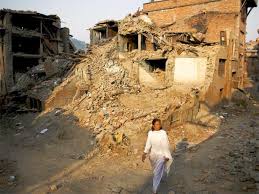Kathmandu, May 25 (PTI) Two tremors today struck Nepal, keeping people on the edge as the country struggled to rehabilitate millions of people affected by a devastating earthquake one month ago that killed nearly 9,000 people.
A 5.0-magnitude tremor was felt at 3.23 am with epicentre at Gorkha district.
Another 4.1-magnitude earthquake hit western Nepal with epicentre at Dolakhan.
A 7.9-magnitude earthquake on April 25 killed nearly 9,000 people and injured thousands more. It was followed by a 7.3-magnitude quake on May 12 and about 265 aftershocks.
For families across Nepal who have been left homeless, the aftershock damaged their hopes of piecing their lives together anytime soon. Beyond the physical damage, uncertainty about the future unsettles millions of Nepalese.
The annual monsoon rains are due to begin in a month.
Families living on precarious hill slopes under tarpaulin sheets fear that landslides triggered by rain and earthquake will cause more havoc.
More than half a million buildings were destroyed in the April 25 quake and aid agencies say they are yet to reach some people in very remote community’s affected by the disaster.
The Nepalese government estimates it will cost more than USD 10 billion for the country to rebuild, a third of the nation’s GDP.
Prime Minister Sushil Koirala is likely to visit India soon to discuss long-term plans on rehabilitation and reconstruction.
Minister for Foreign Affairs Mahendra Bahadur Pandey yesterday briefed Kathmandu-based Consul Generals on the scale of damage caused by the devastating earthquake and its aftershocks as well as on the measures taken by the government for relief, rehabilitation and reconstruction works.
He said that the government has set up the Reconstruction and Rehabilitation Fund with a target of collecting Rs 200 billion and has already transferred Rs 20 billion to the fund as seed money.
He also said that the funds required for rehabilitation and reconstruction could be much higher than the current estimates, according to the statement.
He asked the diplomats to communicate Nepalese government’s rehabilitation and reconstruction plans and initiatives to the governments they represent and play a proactive role in garnering more cooperation and support.
According to UNICEF, an estimated 70,000 children under five are at risk of malnutrition and require urgent humanitarian support.
Around 15,000 children in 14 of the worst-hit districts need therapeutic foods for the treatment of ‘severe acute’ malnutrition.
Additionally, some 55,000 children with ‘moderate acute’ malnutrition require supplementary feeding and care to bring them back to healthy growth and development.








